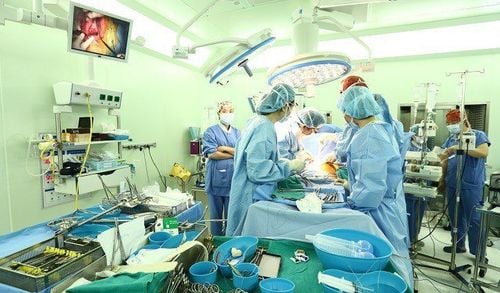This is an automatically translated article.
Cirrhosis is a condition in which liver cells are severely damaged by many different causes, causing loss of function of liver cells. In particular, cirrhosis ascites is a stage of the cirrhosis process. So is cirrhosis of the liver ascites contagious?
1. Cirrhosis is a dangerous disease
Cirrhosis is a condition in which liver cells are damaged for a long time, fibrous tissue has gradually replaced the liver parenchyma, causing liver function to be severely reduced. Cirrhosis can lead to many dangerous complications.Severe advanced cirrhosis can cause the patient to fall into a coma because the liver cannot filter ammonia, causing brain toxicity. When decompensated cirrhosis can turn to liver cancer, causing death in a very short time.

Xơ gan gây ra nhiều biến chứng nguy hiểm
2. What is decompensated cirrhosis?
Cirrhosis is divided into 4 levels, in which cirrhosis ascites is the final stage of cirrhosis.
Grade 1: the liver begins to become inflamed and scar tissue forms, the damage is not significant and can be restored. Grade 2: fibrous scar tissue appears more, portal hypertension, liver damage begins to be more.. Grade 3: fibrous tissue appears more in the liver, patient is tired, pale, anemic, painful liver function, liver function is severely reduced... Grade 4: the most serious because fibrous tissue has completely replaced liver cells leading to severe liver failure, manifested as cirrhosis ascites, weight loss, anemia, Severe jaundice... Cirrhosis ascites will cause the patient's abdomen to swell due to the accumulation of fluid in the abdomen, black stools, yellow skin, severe pain in the liver or may fall into a comatose state. At this stage, patients with cirrhosis ascites often suffer severe damage and can lead to death.

Xơ gan cổ trướng sẽ khiến bụng của bệnh nhân phình to ra
3. Is cirrhosis and ascites contagious?
Whether cirrhosis of the liver ascites is contagious depends on the cause of the disease. If cirrhosis of the liver ascites is caused by abuse of alcohol, beer, tobacco, accumulation of toxins, cardiovascular disease, enteritis, congenital cirrhosis... then even if it has progressed to the stage Cirrhosis ascites is still not contagious to others.
However, when the cause of cirrhosis is caused by organisms such as viruses (hepatitis B ...), parasites, this is an infectious agent for others. The routes of infection with the causative agent of cirrhosis and ascites are as follows:
Mother-to-child transmission: Pregnant women with a history of hepatitis B will have a risk of causing the fetus to contract the disease during childbirth. Sexual transmission: Hepatitis B virus can be transmitted through unprotected sex, especially between husband and wife, there will be a high chance of infection. Blood-borne: injecting or sharing unsafe syringes can spread cirrhosis of the liver ascites to others. Transmission through wounds: when a scratch or skin lesion has direct contact with the hepatitis B virus, the risk of infection is very high.

Xơ gan cổ trướng có thể lây từ mẹ sang con
4. Can cirrhosis of the liver ascites be treated?
When the patient has entered stage 4 cirrhosis or cirrhosis of the liver, the disease will no longer be able to recover completely, the liver cells have almost all fibrosis, no longer have the detoxification function. The treatment methods for cirrhosis of the liver and ascites only aim to minimize pain, limit and prevent dangerous complications that may occur:
Aspiration ascites is performed at an early stage, however the method is This can cause complications such as outbreaks, infections... life-threatening. Liver transplant: the last method to treat the disease, but the cost is relatively high. Treatment of fluid absorption by using drugs in combination with nutrition to limit the absorption of water and ascites in the abdomen, reduce pressure on the liver, kidneys, and abdomen.













